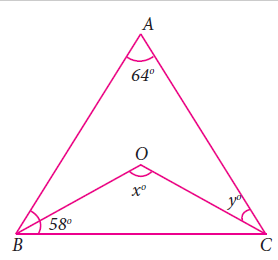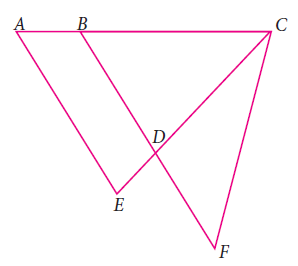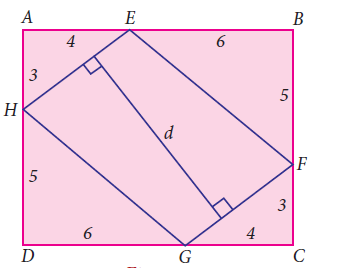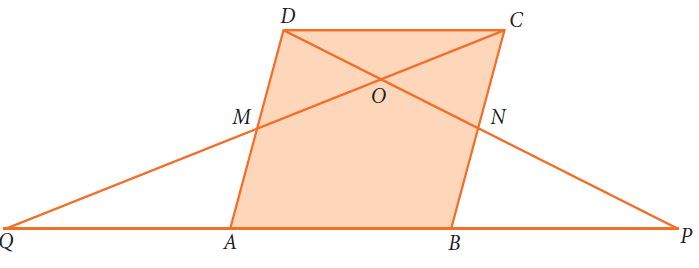PRACTICE PROBLEMS IN GEOMETRY FOR 9TH GRADE
Subscribe to our ▶️ YouTube channel 🔴 for the latest videos, updates, and tips.
Question 1 :
In the given, ∠A = 64° , ∠ABC = 58°. If BO and CO are the bisectors of ∠ABC and ∠ACB respectively of ΔABC, find x° and y°

Solution :
Since BO and CO are bisectors of ABC and ACB.
<OBC = 58/2 = 29
In triangle ABC,
<ABC + <BAC + <BCA = 180
58 + 64 + <BCA = 180
<BCA = 180 - 122
<BCA = 58
<y = 58
In triangle OBC,
<OBC + <BOC + <BCO = 180
29 + <BOC + 29 = 180
<BOC = 180 - 58
x = <BOC = 122
Question 2 :
In the given, if AB = 2, BC = 6, AE = 6, BF = 8, CE = 7, and CF = 7, compute the ratio of the area of quadrilateral ABDE to the area of ΔCDF.

Solution :
Here we have three triangles, Δ AEC, Δ BCF and Δ BDC.
Triangle BCD which is similar to ACE.
In triangle AEC,
AC = AB + BC = 2 + 6 = 8 cm
AE = 6 cm and EC = 7 cm
a = 8, b = 6 and c = 7
Using a formula for area of scalene triangle
= √s(s - a) (s - b) (s - c)
= √10.5(2.5) (4.5) (3.5)
= √413.43
= 20.33 ----(1)
In triangle BFC
BF = 8 cm , BC = 6 cm, and CF = 7 cm
s = (8 + 6 + 7)/2 = 10.5
= √s(s - a) (s - b) (s - c)
= √10.5(2.5) (4.5) (3.5)
= √413.43
= 20.33 ----(1)
Triangle BCD which is similar to ACE.
And BCF
To gets lengths BD and CD for triangle BCD we will use linear scale factor.
We get lsf from lengths AC and BC as follows :
8/6 = 4/3
8(BF) /BD = 4/3
24 = 4BD
BD = 24/4 = 6
CE/CD = 8/6
7/(CD) = 8/6
42 = 8CD
CD = 42/8
= 5.25
Area of BCD :
S = (6 + 6+, 5.25) /2 = 8.625
A = √8.625(8.625 - 6)(8.625 - 6)(8.625 - 5.25)
= √200.58
= 14.16
Area of CDF :
S = (5.25 + 7 + 2) / 2 = 7.125
A = √7.125(7.125 - 5.25) (7.125 - 7)(7.125 - 2)
= √8.558 = 2.925
= 2.925
Area of ABDE.
= 20.33 - 14.16 = 6.17
The ratio of ABDE : CDF
= 6.17 : 2.925
Approximately : 6 : 3
= 2 : 1
Question 3 :
In the figure, ABCD is a rectangle and EFGH is a parallelogram. Using the measurements given in the figure, what is the length d of the segment that is perpendicular to HE and FG?

Question 4 :
In parallelogram ABCD of the accompanying diagram, line DP is drawn bisecting BC at N and meeting AB (extended) at P. From vertex C, line CQ is drawn bisecting side AD at M and meeting AB (extended) at Q. Lines DP and CQ meet at O. Show that the area of triangle QPO is 9/8 of the area of the parallelogram ABCD.

Solution :
[QPO] = [QAM] + [PBM] + [AMONB] -----(1)
[QPO] = [AMONB] + [MDC] + [NCD] -----(2)
From (2),
= [AMONB] + [MDC] + [NOC] + [DOC]
= [ABCD] + [DOC]
Let [ABCD] = K
= K + [DOC]
[DCNM ] is also a parallelogram.
So,
[DOC] = 1/4 [DCNM] , 2[ABCD] = [DCNM]
= 1/8 [ABCD]
= k/8
[QPO] = K + K/8
[ [QPO] = 9k/8 ]
Hence proved.
Subscribe to our ▶️ YouTube channel 🔴 for the latest videos, updates, and tips.
Kindly mail your feedback to v4formath@gmail.com
We always appreciate your feedback.
About Us | Contact Us | Privacy Policy
©All rights reserved. onlinemath4all.com

Recent Articles
-
ASTC Formula in Trigonometry
Dec 23, 25 11:34 PM
ASTC Formula in Trigonometry - Concepts - Examples and Solved Problems -
Coin Tossing Probability
Dec 23, 25 11:29 PM
Coin Tossing Probability - Concept - Sample Space - Formula - Solved Problems -
Permutation and Combination
Dec 23, 25 11:28 PM
Permutation and Combination - Definition - Formulas - Shortcuts - Difference between permutation and combination
